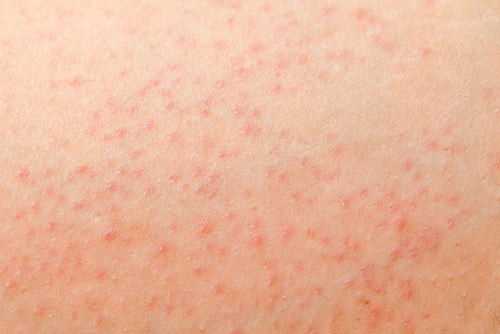Dr. Zenovia Skincare aims to showcase the stories of real people. In this post, Lindsay shares her story of discovering that her acne-like breakouts were actually a skin infection known as folliculitis. Everyone has a unique perspective and story to share.
For the longest time, I thought the pimples on my shoulders, chest, back, and stomach was body acne. They were itchy and felt nearly impossible to clear up and maintain. I initially thought it was due to sweat, but learned what was going on was anything but!
Acne-like Breakouts: Folliculitis
I discovered I have a common skin infection called Folliculitis. Folliculitis involves the inflammation of the hair follicle and can be yeast or bacterial; they resemble baby pimples all over the body. It’s easily confused with acne because it looks so similar!
If you are like me, hoping to get rid of your folliculitis, this post is for you. I wrote this in collaboration with Dr. Zenovia to share information on folliculitis and how to treat it. Here is what you need to know.
Sweat Doesn’t Cause Acne
First of all, I was mind blown when Dr. Zenovia told me this. What!? She revealed, “Sweat itself does not cause acne. Sweat actually regulates the body’s temperature. Sweat is sterile. When sweat gets dirty it comes on top of the skin and mixes with the outside dirt or bacteria."
Body Acne vs. Folliculitis
Acne is the buildup of dirt, bacteria, and an overproduction of oil that causes pimples. Additional factors that can contribute to body acne include your lifestyle, diet, and hormone fluctuations which cause your body to produce more oil.
As I explained earlier, folliculitis looks similar to acne; but can appear anywhere on the body. You likely have experienced folliculitis as razor burn. There are two types of folliculitis: yeast & bacterial. Yeast folliculitis, also known as Pityrosporum folliculitis, happens when yeast that naturally lives on your body gets into the hair follicles and multiplies. Bacterial folliculitis is more common and caused by staph bacteria (Staphylococcus aureus). They can both appear anywhere on the body.
Dr. Zenovia explains it like this: “I want you to think about dandruff. People make dandruff, and then some people don't. Dandruff is not something that you can cure. Your body's scalp has a tendency to flake or not flake, based on the yeast profile in your hair. So essentially, people who make folliculitis always make it.”
This is why folliculitis is so hard to resolve. We all live with staph & yeast on our bodies. Some people have a tendency to overgrow and get folliculitis, and others do not.
“It goes away, but six months later, it comes back! This is because your immune system is allowing the staph to get too populated”, Dr. Zenovia explains “It then infects your hair follicles, and you get tiny pimples.”
Folliculitis At-Home Treatments
In terms of treatment, your doctor will first need to determine if you have acne or folliculitis & what type. If you are diagnosed with bacterial folliculitis, Dr. Zenovia says, “The best way to control it is to wash with an antibacterial soap. In the old days, we used to use Dial; Dial has a lot of antibacterial properties. Use an antibacterial cleanser three times a week for a month, and if it continues, go back and do it again.”
If you have Pityrosporum Folliculitis, Dr. Zenovia recommends using Selsun Blue or asking your doctor to prescribe a 2% Ketoconazole Shampoo. For Pityrosporum Folliculitis you will need to wash with antifungal agents.
Here are Dr. Zenovia’s tips on how to properly use topicals to treat folliculitis:
- Wash Behind Your Ears: Believe it or not, there’s an actual reason why they say to wash behind your ears! Dr. Zenovia explains, “The three areas that you want to focus on are behind your ears, your armpits, and your groin. A lot of people don't get that. You don’t want to wash the areas you get pimples. You want to wash the areas that harbor the bacteria, which is the armpits, groin, and back of their ears.”
- Opt for Oral Antibiotics or an Antibacterial Ointment: Depending on the degree of severity, your doctor can prescribe oral antibiotics or an antibacterial ointment. “Sometimes, I recommend antibacterial ointment up your nostrils. Whether you have the rash or not, you use the ointment up your nostrils because the nose is a location where bacteria colonizes, causing a rash to come and go. I prefer not to wait until you get a rash to treat you with oral antibiotics. I'd rather treat your nose, get you stable, and keep you balanced so you're not breaking out,” Dr. Zenovia added.
And that’s the difference between folliculitis from acne! I would be lying if I said I’ve gotten my folliculitis completely under control as I write this. It makes sense why I’ve struggled- I have been washing my entire body with some of the washes described above, wondering why it wasn’t working for years! I never knew to wash behind my ears & target the areas the staph or yeast populate. I can’t believe no one ever told me that- this is why we have Dr. Zenovia.
Folliculitis is so tricky to beat because it comes and goes, requiring more finesse. As I get back on my journey to healing, I hope these tips help you as I know they will help me.
*Note: Dr. Zenovia has not treated me. She simply gave me recommendations over a virtual skin consultation.
Written by Lindsay Hoffman, Journalist, Blogger, TV Host, and the Co-Founder of MashupLA


